1997 TOYOTA TACOMA check engine light
[x] Cancel search: check engine lightPage 62 of 221
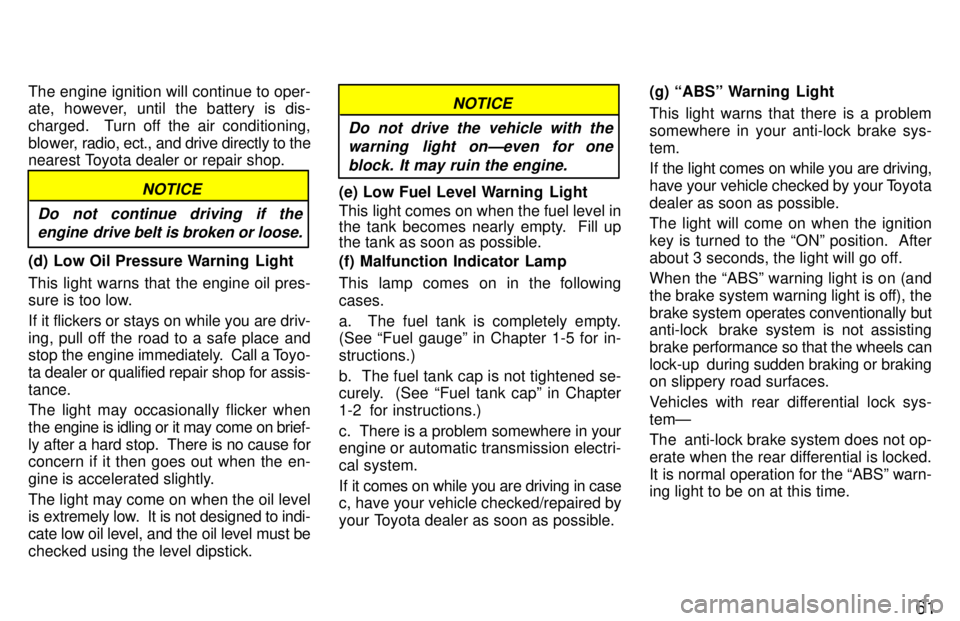
61
The engine ignition will continue to oper-
ate, however, until the battery is dis-
charged. Turn off the air conditioning,
blower, radio, e
ct., and drive directly to the
nearest Toyota dealer or repair shop.
NOTICE
Do not continue driving if the engine drive belt is broken or loose.
(d) Low Oil Pressure Warning Light
This light warns that the engine oil pres-
sure is too low.
If it flickers or stays on while you are driv-
ing, pull off the road to a safe place and
stop the engine immediately. Call a Toyo-
ta dealer or qualified repair shop for assis- tance.
The light may occasionally flicker when
the engine is idling or it may come on brief-
ly after a hard stop. There is no cause for concern if it then goes out when the en-
gine is accelerated slightly.
The light may come on when the oil level
is extremely low. It is not designed to indi- cate low oil level, and the oil level must bechecked using the level dipstick.
NOTICE
Do not drive the vehicle with the warning light onÐeven for one
block. It may ruin the engine.
(e) Low Fuel Level Warning Light
This light comes on when the fuel level in
the tank becomes nearly empty. Fill up the tank as soon as possible. (f) Malfunction Indicator Lamp
This lamp comes on in the following cases.
a. The fuel tank is completely empty. (See Fuel gaugeº in Chapter 1-5 for in- structions.)
b. The fuel tank cap is not tightened se-
curely. (See Fuel tank capº in Chapter
1-2 for instructions.)
c. There is a problem somewhere in your
engine or automatic transmission electri- cal system.
If it comes on while you are driving in case
c, have your vehicle checked/repaired by
your Toyota dealer as soon as possible. (g) ABSº Warning Light
This light warns that there is a problem
somewhere in your anti-lock brake sys-tem.
If the light comes on while you are driving,
have your vehicle checked by your T
oyota
dealer as soon as possible.
The light will come on when the ignition
key is turned to the ONº position. After
about 3 seconds, the light will go off. When the ABSº warning light is on (and
the brake system warning light is off), thebrake system operates conventionally but
anti-lock brake system is not assistingbrake performance so that the wheels can
lock-up during sudden braking or braking
on slippery road surfaces.
Vehicles with rear differential lock sys- temÐ
The anti-lock brake system does not op-
erate when the rear differential is locked.
It is normal operation for the ABSº warn-
ing light to be on at this time.
Page 63 of 221
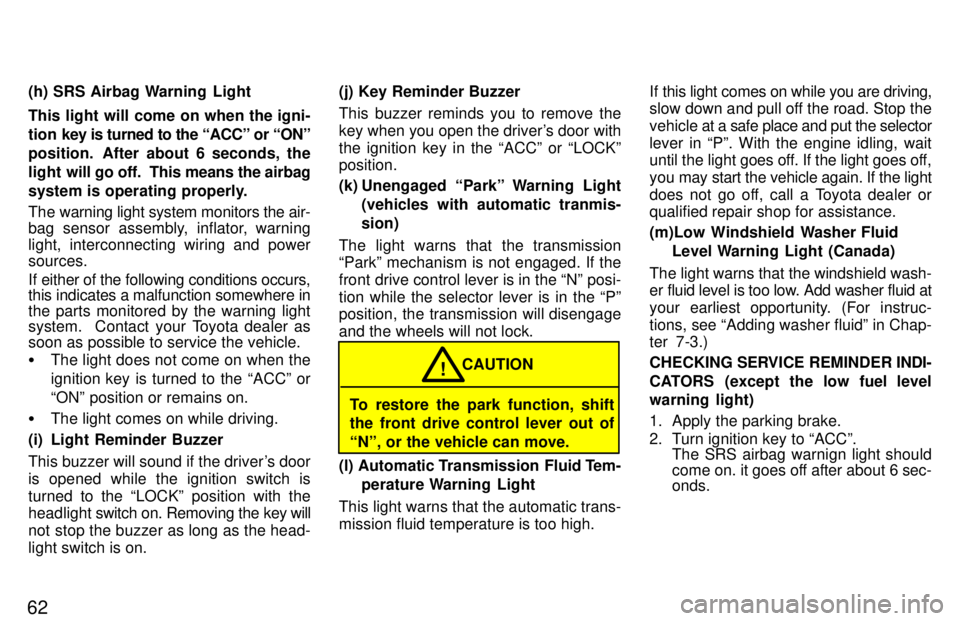
62(h) SRS Airbag Warning Light
This light will come on when the igni-
tion
key is turned to the ACCº or ONº
position. After about 6 seconds, the
light w ill go off. This means the airbag
system is operating properly.
The warning light system monitors the air-
bag sensor assembly, inflator, warning light, interconnecting wiring and power sources.
If either of the following conditions occurs, this indicates a malfunction somewhere in the parts monitored by the warning light
system. Contact your Toyota dealer as
soon as possible to service the vehicle. � The light does not come on when the
ignition key is turned to the ACCº or
ONº position or remains on.
� The light comes on while driving.
(i) Light Reminder Buzzer
This buzzer will sound if the driver's door is opened while the ignition switch isturned to the LOCKº position with the
headlight switch on. Removing the key will
not stop the buzzer as long as the head- light switch is on. (j) Key Reminder Buzzer
This buzzer reminds you to remove the
key when you open the driver's door withthe ignition key in the ACCº or LOCKº position.
(k) Unengaged Parkº Warning Light
(vehicles with automatic tranmis- sion)
The light warns that the transmission
Parkº mechanism is not engaged. If the
front drive control lever is in the Nº posi-
tion while the selector lever is in the Pº
position, the transmission will disengage
and the wheels will not lock.
To restore the park function, shift
the front drive control lever out of
Nº, or the vehicle can move. CAUTION
!
(l) Automatic Transmission Fluid Tem- perature Warning Light
This light warns that the automatic trans- mission fluid temperature is too high. If this light comes on while you are driving,
slow down and pull off the road. Stop the
vehicle at a
safe place and put the selector
lever in Pº. With the engine idling, wait
until the light goes off. If the light goes off,
you may start the vehicle again. If the light
does not go off, call a Toyota dealer or
qualified repair shop for assistance.
(m)Low Windshield Washer Fluid
Level Warning Light (Canada)
The light warns that the windshield wash-
er fluid level is too low. Add washer fluid at
your earliest opportunity. (For instruc-
tions, see Adding washer fluidº in Chap- ter 7-3.)
CHECKING SERVICE REMINDER INDI-
CATORS (except the low fuel level
warning light)
1. Apply the parking brake.
2. Turn ignition key to ACCº. The SRS airbag warnign light should
come on. it goes off after about 6 sec- onds.
Page 64 of 221

63
3. Turn the ignition key to ONº, but do
not start the engine.
All the service reminder indicators ex-
cept the SRS airbag warning light
should come on. The ABSº warning
light goes off after about 3 seconds.
If any service reminder indicator or warn-
ing buzzer does not function as describedabove, either the bulb is burned out or the
circuit is in need of repair. Have it checked
by your Toyota dealer as soon as pos- sible.
Page 78 of 221
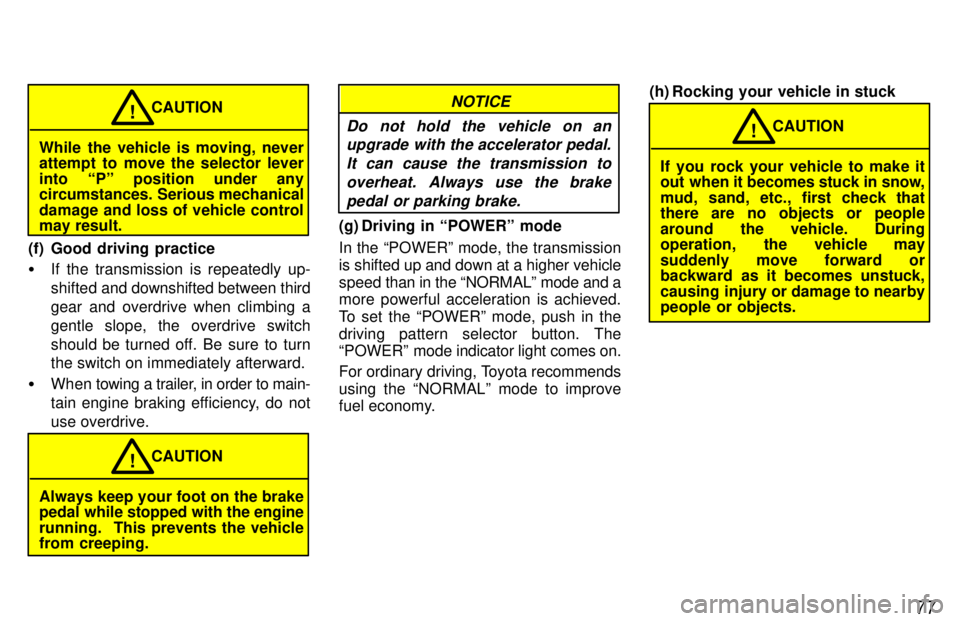
77
While the vehicle is moving, never
attempt to move the selector lever
into Pº position under any
circumstances. Serious mechanical
damage and loss of vehicle control may result.CAUTION
!
(f) Good driving practice � If the transmission is repeatedly up-
shifted and downshifted between third
gear and overdrive when climbing a
gentle slope, the overdrive switch
should be turned off. Be sure to turn the switch on immediately afterward.
� When towing a trailer, in order to main-
tain engine braking efficiency, do notuse overdrive.
Always keep your foot on the brake
pedal while stopped with the engine
running. This prevents the vehicle
from creeping. CAUTION
!
NOTICE
Do not hold the vehicle on an upgrade with the accelerator pedal.
It can cause the transmission tooverheat. Always use the brake pedal or parking brake.
(g) Driving in POWERº mode In the POWERº mode, the transmission
is shifted up and down at a higher vehicle
speed than in the NORMALº mode and a
more powerful acceleration is achieved.
To set the POWERº mode, push in the
driving pattern selector button. The
POWERº mode indicator light comes on.
For ordinary driving, Toyota recommends
using the NORMALº mode to improve
fuel economy. (h) Rocking your vehicle in stuck
If you rock your vehicle to make it
out when it becomes stuck in snow,
mud, sand, etc., first check that there are no objects or people
around the vehicle. During
operation, the vehicle may suddenly move forward or
backward as it becomes unstuck,
causing injury or damage to nearby
people or objects.
CAUTION
!
Page 89 of 221
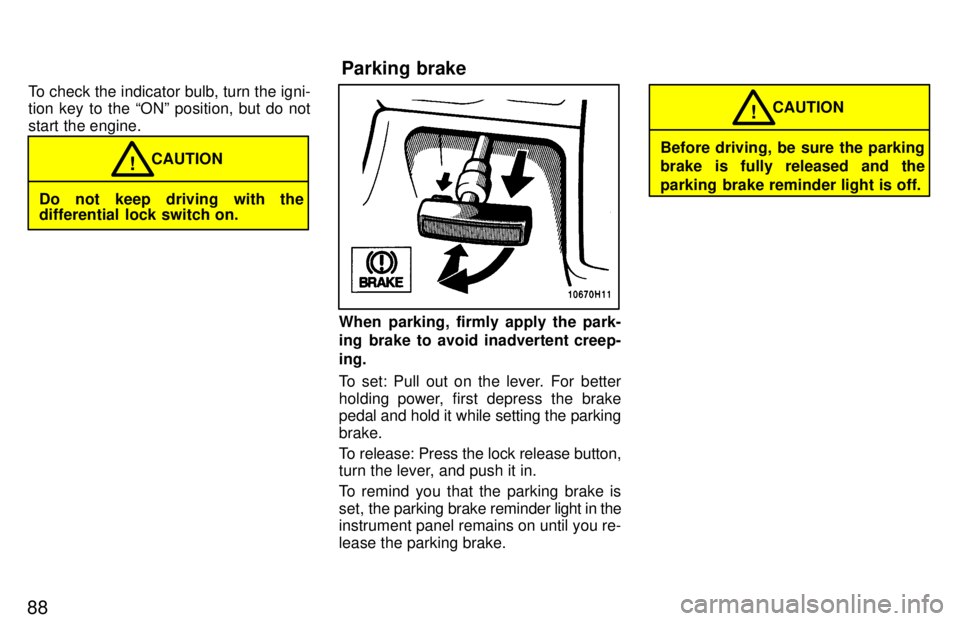
88To check the indicator bulb, turn the igni-
tion key to the ONº position, but do not
start the engine.
Do not keep driving with the
differential lock switch on.
CAUTION
!
When parking, firmly apply the park-
ing brake to avoid inadvertent creep- ing.
To set: Pull out on the lever. For better
holding power, first depress the brake
pedal and hold it while setting the parking brake.
To release: Press the lock release button,
turn the lever, and push it in.
To remind you that the parking brake is
set,
the parking brake reminder light in the
instrument panel remains on until you re-lease the parking brake.
Before driving, be sure the parking
brake is fully released and the
parking brake reminder light is off. CAUTION
!
Parking brake
Page 91 of 221
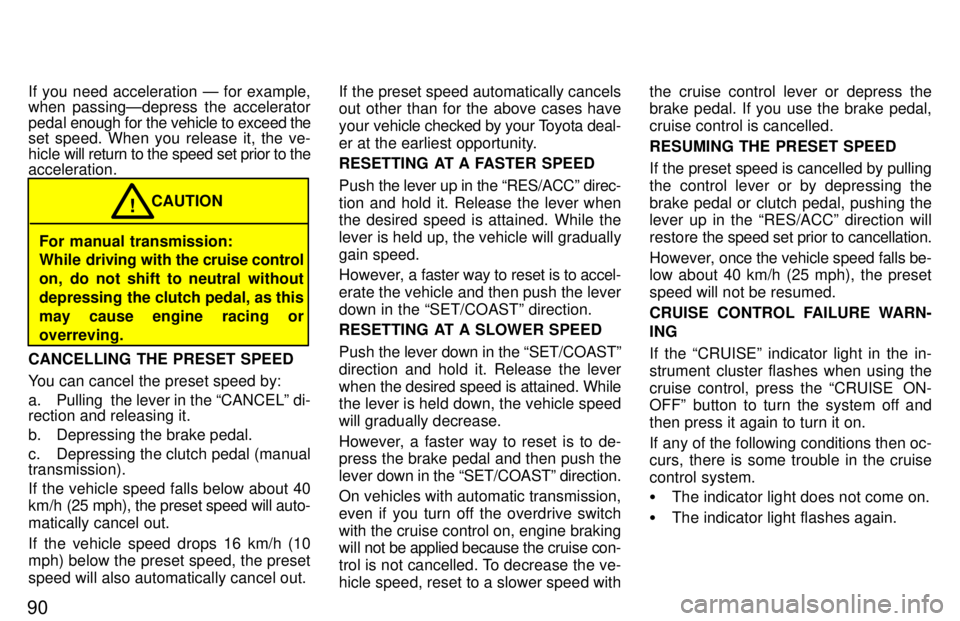
90If you need acceleration Ð for example,
when passingÐdepress the accelerator
pedal
enough for the vehicle to exceed the
set speed. When you release it, the ve-
hicle will return to the speed set prior to the
acceleration.
For manual transmission:
While driving with the cruise control
on, do not shift to neutral without
depressing the clutch pedal, as this
may cause engine racing oroverreving. CAUTION
!
CANCELLING THE PRESET SPEED
You can cancel the preset speed by:
a. Pulling the lever in the CANCELº di- rection and releasing it.
b. Depressing the brake pedal.
c. Depressing the clutch pedal (manual transmission).
If the vehicle speed falls below about 40
km/h (25 mph), the preset speed will auto-
matically cancel out.
If the vehicle speed drops 16 km/h (10 mph) below the preset speed, the preset speed will also automatically cancel out. If the preset speed automatically cancels
out other than for the above cases have your
vehicle checked by your Toyota deal-
er at the earliest opportunity.
RESETTING AT A FASTER SPEED Push the lever up in the RES/ACCº direc-
tion and hold it. Release the lever when
the desired speed is attained. While the
lever is held up, the vehicle will graduallygain speed.
However, a faster way to reset is to accel-
erate the vehicle and then push the lever down in the SET/COASTº direction.
RESETTING AT A SLOWER SPEED Push the lever down in the SET/COASTº
direction and hold it. Release the lever
when the desired speed is attained. While
the lever is held down, the vehicle speedwill gradually decrease.
However, a faster way to reset is to de- press the brake pedal and then push the
lever down in the SET/COASTº direction.
On vehicles with automatic transmission,
even if you turn off the overdrive switchwith the cruise control on, engine braking
will not be applied because the cruise con-
trol is not cancelled. To decrease the ve-
hicle speed, reset to a slower speed with the cruise control lever or depress the brake pedal. If you use the brake pedal, cruise control is cancelled. RESUMING THE PRESET SPEED
If the preset speed is cancelled by pulling
the control lever or by depressing the
brake pedal or clutch pedal, pushing the
lever up in the RES/ACCº direction will
restore
the speed set prior to cancellation.
However, once the vehicle speed falls be-
low about 40 km/h (25 mph), the preset
speed will not be resumed.
CRUISE CONTROL FAILURE WARN- ING
If the CRUISEº indicator light in the in-
strument cluster flashes when using the
cruise control, press the CRUISE ON-
OFFº button to turn the system off and then press it again to turn it on.
If any of the following conditions then oc-
curs, there is some trouble in the cruise control system. � The indicator light does not come on.
� The indicator light flashes again.
Page 120 of 221
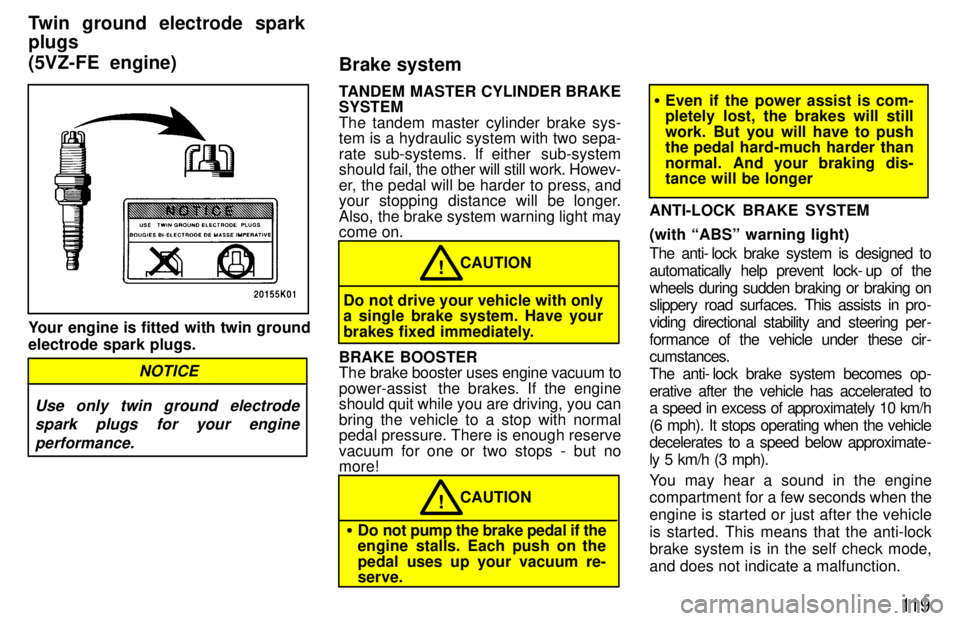
11 9
Your engine is fitted with twin ground electrode spark plugs.
Use only twin ground electrodespark plugs for your engine
performance.
NOTICE
TANDEM MASTER CYLINDER BRAKE SYSTEM
The tandem master cylinder brake sys-
tem is a hydraulic system with two sepa-
rate sub-systems. If either sub-system
should fa il, the other will still work. Howev-
er, the pedal will be harder to press, and
your stopping distance will be longer.
Also, the brake system warning light may come on.
CAUTION!
Do not drive your vehicle with only
a single brake system. Have your
brakes fixed immediately.
BRAKE BOOSTER
The brake booster uses engine vacuum to
power-assist the brakes. If the engine
should quit while you are driving, you can
bring the vehicle to a stop with normal
pedal pressure. There is enough reserve
vacuum for one or two stops - but no more!
CAUTION!
� Do not pump the brake pedal if the
engine stalls. Each push on the
pedal uses up your vacuum re- serve.
�Even if the power assist is com-
pletely lost, the brakes will still
work. But you will have to push
the pedal hard-much harder than
normal. And your braking dis- tance will be longer
ANTI-LOCK BRAKE SYSTEM (with ABSº warning light)
The anti- lock brake system is designed to
automatically help prevent lock- up of the
wheels during sudden braking or braking on
slippery road surfaces. This assists in pro-
viding directional stability and steering per -
formance of the vehicle under these cir -
cumstances.
The anti- lock brake system becomes op-
erative after the vehicle has accelerated to
a speed in excess of approximately 10 km/h
(6 mph). It stops operating when the vehicle
decelerates to a speed below approximate-
ly 5 km/h (3 mph).
You may hear a sound in the engine
compartment for a few seconds when the
engine is started or just after the vehicle is started. This means that the anti-lock
brake system is in the self check mode,
and does not indicate a malfunction.
Twin ground electrode spark plugs
(5VZ-FE engine)
Brake system
Page 128 of 221
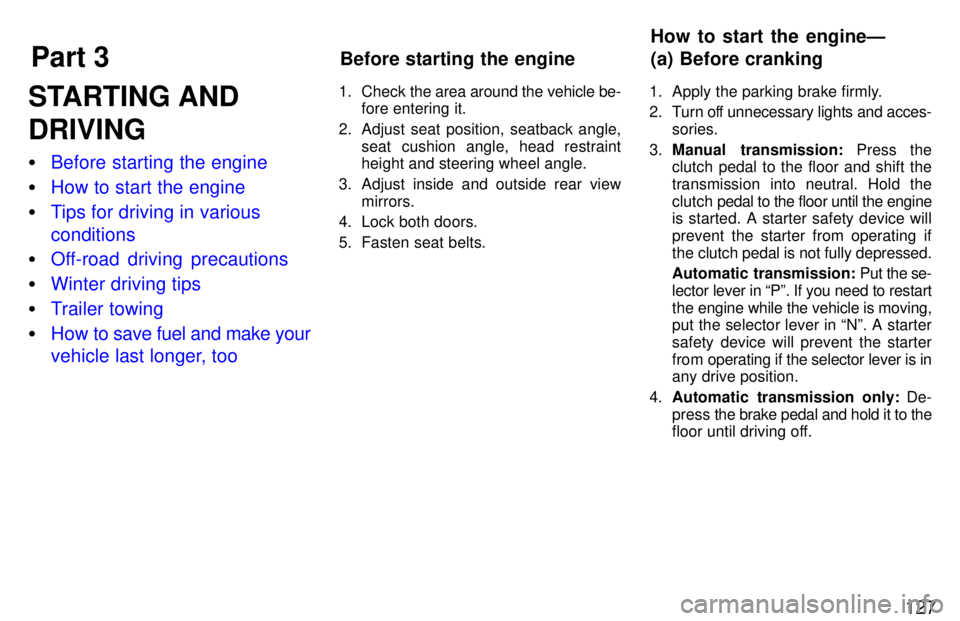
Part 3How to start the engineÐ
(a) Before cranking
Before starting the engine
127
STARTING AND DRIVING �
Before starting the engine
�How to start the engine
�Tips for driving in various conditions
�Off-road driving precautions
�Winter driving tips
�Trailer towing
�How to save fuel and make your
vehicle last longer, too
1. Check
the area around the vehicle be-
fore entering it.
2. Adjust seat position, seatback angle, seat cushion angle, head restraint
height and steering wheel angle.
3. Adjust inside and outside rear view mirrors.
4. Lock both doors.
5. Fasten seat belts. 1. Apply the parking brake firmly.
2. Turn off unnecessary lights and acces-
sories.
3. Manual transmission: Press the
clutch pedal to the floor and shift the
transmission into neutral. Hold theclutch pedal to the floor until the engine
is started. A starter safety device willprevent the starter from operating if
the clutch pedal is not fully depressed.
Automatic transmission: Put the se-
lector lever in Pº. If you need to restart
the engine while the vehicle is moving, put the selector lever in Nº. A starter
safety device will prevent the starter
from operating if the selector lever is in
any drive position.
4. Automatic transmission only: De-
press the brake pedal and hold it to the
floor until driving off.